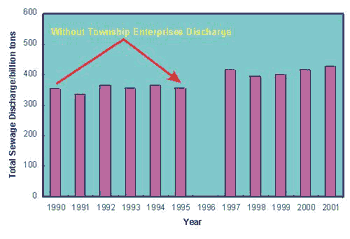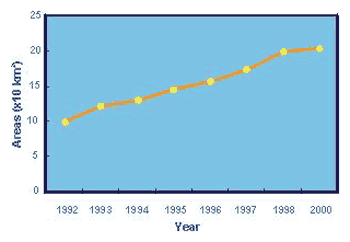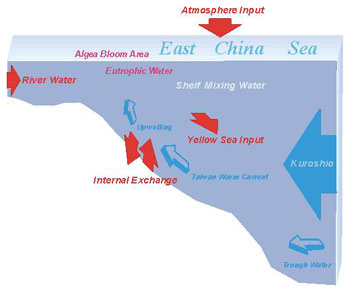|
Session 2
Maritime Security: Marine Environment Protection
Session 2-1 |
Ocean Pollution from Land Based Sources: East China Sea, China |
Session 2-2 |
Protection of the Marine Environment from Sea-Based Pollution |
Session 2-3 |
DILEMMAS AND APPROACHES IN THE NEW OCEAN REGIME: THE INTEGRATION OF RESOURCE UTILIZATION AND ENVIRONMENTAL PROTECTION |
Session 2-4 |
Paradigm Shift in Shipping and Preventing Marine Pollution |
Session 2-5 |
WSSD and Ocean Issues |
Discussions |
Session 2-1
Ocean Pollution from Land Based Sources: East China Sea, China
Li Daoji
Introduction
The environment of East China Sea has been faced on huge stress from anthropogenic activities and population growth in the Yangtze River drainage basin and the areas along the coasts since the recent two decades. Some pollutants from land-based sources, such as: sewage, oil hydrocarbons, sediments, nutrients, pesticides, litter and marine debris, toxic wastes, consequently transfer to the ocean to constitute the greatest real or perceived threat to coastal and marine ecosystems as well as the public health of coastal dwellers by causing phytoplankton growth limited, fish and benthos dead, eutrophication enhancing, red tide frequently occurring, fishery yield decreasing, and nonreversible changes of ecosystem healthy. In addition, The Three Gorge Dam (TGD) construction, the South to North Water Transfer engineering and sea level rising caused by global climate warming will also bring new impacts on it. Therefore, deep study and impersonal evaluation on these impacts are needed for protecting marine ecosystem and supporting sustainable development of society, economic and environment of the countries and areas around the East China Sea.
Since 70s, developed countries have begun to undertake relevant basic study on environment of coastal ocean. By 90s, remarkable environment melioration came to true. Recently, they begin to focus on aspects of mechanism of ecosystem service, ecosystem healthy, ecosystem restoration, and ecosystem diversity protection, and emphasize international corporations of macro-scale studies on these. The UN Conference on Environment and Development held in Rio de Janeiro in 1992 and the Agenda 21 of China had proposed the significant role and special status of protecting coastal resources and ecosystem healthy on both sustainable using of marine resources and sustainable development of human being.
During 1958-1960 China had carried out a large program of National Ocean Integrated Investigation. Afterwards, the National Coastal Zone Resource Integrated Investigation and the National Islands Resource Integrated Investigation had been done during 1980-1986, 1989-1992 respectively. After that, other large research programs for coastal oceans were also undertaken. These make a certain basis for us to understand the present situations of coastal ocean ecosystem healthy and marine resources. Currently, China has begun to start a large program called "Verdure Sea" to regulate and restore Bohai ecosystem with an investment of about 10 billion Yuan, and a same program is also going to be performed in the Pearl River estuary, Guangdong province, that will mitigate environmental stresses from anthropogenic activities on coastal ocean effectively. Meantime, a series environment regulation projects are also carried out in cities along the Yangtze River basin. However, action and investment for ameliorating environment issues in the Yangtze River estuary and adjacent East China Sea still lag behind above areas despite its economic scale and investment proportion on economic development are large far from them.
This paper attempts to introduce environmental evolution and evaluate present environmental situation of the East China Sea, to promote extensive and high level discussion on some questions of influencing the ecosystem for making some strategies of preventing Ocean pollution and protecting the ecosystem of East China Sea effectually in future.
|
Position: Professor, State Key Laboratory of Estuarine and Coastal Research, East China Normal University
Education: Ocean University of Qingdao graduate / Ph.D. degree, State Key Laboratory of Estuarine and Coastal Research, East China Normal University
Li is engaged in research work on the field of estuarine and coastal ecology at East China Normal University. From 1989 to 1990, he, as a visiting scholar, worked at the Netherlands Institute for Sea Research and the Delta Institute of Hydrobiological Research. At present, at the State Laboratory of Estuarine and Coastal Research, he is studying the ecosystems and biogeochemical processes of the Changjiang (Yangtze River) estuary and the adjacent East China Sea and the impacts of environmental pollution of the Yangtze River basin on the Yangtze River estuary and the East China Sea.
|
|
|
General Situation of the Coastal Ocean Pollution of China
Total population along the coastal provinces of china is about 0.5 billion, besides there is a great amount of mobile population staying along the coastal area. It is estimated that the tendency of population migrating from the mid and western to the eastern coasts may not be changed before 2020 and also 0.08〜0.1 billion population per year will stay along the coastal area. Huge population along coastal area must cause very shortage of living space, heavy pollution and serials of environmental problems, such as sewage discharge increasing (Fig.1). Especially, About 80 percent of ocean pollutants are come from land and it is inevitably. A majority of pollutants caused is discharged and dumped directly into ocean. Only sewage and main toxic materials discharged into ocean from factories and cities along china coasts are more than 10 billion tons and 146 million tons per year respectively.
In 2001 , the water areas of china coastal ocean where sea water quality was worse than the Class I of the Sea Water Quality Standard (SWQS, GB3097-1997) of China reached more than 173,000 km2 (Fig.2), in which very heavy pollution areas worse than the Class IV of SWQS is about 32,000 km2, mainly distributing in mid and large city coastal oceans and estuaries with high population density. The very heavy pollution areas expanded 4,000 km2 comparing with that in 2000. Drain contamination still is a top factor of coastal ocean environmental pollution at present. The dominating pollutants are inorganic nitrogen, phosphate, oil hydrocarbons, organic matters and heavy metals. Although runoff volume of industry sewage directly into coastal ocean has been decreasing since 1999, living sewage and sea runoff contaminates face on increasing trend. The red tide events occurred 28 times with involved areas 10,000 km2 in 2000 and 77 times with involved areas reached 15,000 km2 in 2001 respectively. On inorganic nitrogen and phosphate pollution in 2001, the light, mid, and very heavy polluted coastal ocean areas by inorganic nitrogen were about 25,000 km2, 14,490 km2 and 32,490 km2 respectively; the mid and very heavy polluted coastal ocean areas by phosphate were 13,000 km2 and 9,232 km2 respectively.
The sediment monitoring data of the coastal ocean of china in 2001 showed that pollution caused by Total-Ag, Cu, Cd, Pb, As, DDT, PCBs, oil hydrocarbons, sulfide, organic matters, and so on mainly focus on different regions with different degrees, these regions are following:
a. Dalian Bay, suffered by Total-Ag, Cu, Pb, oil hydrocarbons, sulfide, organic matters pollution, in which, the maximum value of sulfide reached 969 mg/kg, exceeding the Class III of the Marine Sediment Quality Standard (MSQS,GB-interim of China); The maximum value of oil hydrocarbons was 7,795 mg/kg, more than 5 times ofMSQS;the maximum value of T-Ag exceeded 3 times of MSQS.
b. Jinzhou Bay, much heavy polluted by heavy metal, Total-Ag, Cu, Cd, and Pb exceeded the Class I of MSQS, in which the highest value of T-Ag was more than 3 times of MSQS; As and sulfide was worse than the Class I of MSQS. About 7km2 of the seabed had no organisms.
c. Qinhuangdao and its adjacent sea, polluted by oil hydrocarbons, sulfide, organic matters, Ag, and Cu, in which, the highest values of oil hydrocarbons and sulfide exceeded the Class III of MSQS; values of organic matters, Total-Ag, and Cu were worse than the Class I of MSQS.
d. Yangtze River estuary and its adjacent sea, contents of DDT exceeded the Class I of MSQS.
e. Beihai coastal ocean, contents of DDT exceeded the Class I of MSQS.
f. Qinzhou Bay, the highest content of DDT exceeded the Class II of MSQS.
g. Minjiang estuary and its adjacent sea, polluted by Ag and oil hydrocarbons, in which, the maximum content of oil hydrocarbons exceeded the Class III of MSQS.
| (拡大画面:26KB) |
 |
Fig. 1 |
Total sewage discharge variations of China from 1990 to 2001 |
| (拡大画面:15KB) |
 |
Fig. 2 |
Areas comparison of water quality worse than the Class I of SWQS along China coastal ocean in 90s |
The pollutant content data of sampling monitoring to 20 species of seashell from 50 sites of 11 provinces along the coasts showed that the quality state of marine organisms in the coastal ocean of china were good basically in 2001, but toxic pollutants in organisms presented in some places and mainly were Cd, oil hydrocarbons and As.
Along with development of coastal economy of china, runoff volume of pollutants into ocean shall has no significant decrease in near future, specially, the persistent organic pollutants loading will be an increasing trend. Therefore, the environmental quality situation along the china coastal ocean is no optimism and high attention on it must be paid.
Main Ways of Land Pollutants into the East China Sea
East China Sea (ECS) is a marginal sea characterized by both shallow and deep-water features. The submarine topographic of ECS is very complicated, its western part is occupied by continental shelf covering about two thirds of the total area of ECS, and the southern part occupied by continental slope and deep trough (Okinawa Trough), with its maximum depth exceeding 2700 m; On the western side a large amount of runoff ca. 12x1011m3yr-1 is discharged into ECS from the Yangtze River (Fig.3). On the eastern side flows the intense Kuroshio; its volume transport is around 20-30 SV. At the same time over the sea surface prevails monsoon, its direction changes twice a year. Since materials carried by Kuroshio and summer monsoon eastward transport into ECS are not contaminated, main ways of pollutants into ECS come from the Yellow Sea and the eastern part; rivers, coasts and atmosphere of china mainland, among them Yangtze River is main source of land based pollutants discharging into ECS (Fig.4).
The Yangtze River is the largest nver in China as well as one of the famous large rivers in the world. It passes through a densely populated area with relatively developed industry and agriculture along the both banks especially Shanghai at its end, the greatest city of China. Therefore environmental pollution of Yangtze River basin has close relation with marine environment quality of ECS.
| (拡大画面:136KB) |
 |
Fig. 3 |
The Yangtze River Drainage Basin |
| (拡大画面:33KB) |
 |
Fig. 4 |
Main ways of land pollutants into the East China Sea |
|